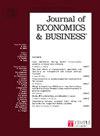Relative impact of digital and traditional financial inclusion on financial resilience: Evidence from 13 emerging countries
IF 3.4
Q1 BUSINESS, FINANCE
引用次数: 0
Abstract
We aim to understand the relative impact of traditional financial inclusion (FI) and digital financial inclusion (DFI) on perceived financial resilience (FR). We use Global Findex data for the years 2014 and 2021. Our sample includes 33933 individuals from 13 emerging economies. FI indicators include bank account ownership, saving, borrowing, payments and receipts. DFI indicators include digital borrowing, receipts and payments. Socio-economic and demographic factors such as age, gender, education and income, and informal financial activities are included as control variables. To address endogeneity issues, we include instrumental variables for each FI and DFI indicator. Individuals from Argentina, Brazil, China, Russia, South Africa and Thailand report higher levels of FI and DFI, while those from Egypt, India, Mexico and the Philippines report low levels. Estimated coefficients from bi-probit models indicate that “savings” had the largest positive impact on FR. Two FI indicators “bank account ownership” and “making payments”, and one DFI indicator “digital payments” had smaller and similar effect sizes. Digital borrowing had a small effect while digital receipts had no effect on FR. Our results indicate that having access to savings plays a larger role in improving individual financial resilience compared to other indicators. Policy implications are discussed.
数字和传统普惠金融对金融韧性的相对影响:来自13个新兴国家的证据
我们的目标是了解传统普惠金融(FI)和数字普惠金融(DFI)对感知金融弹性(FR)的相对影响。我们使用的是2014年和2021年的全球Findex数据。我们的样本包括来自13个新兴经济体的33933个人。金融融通指标包括银行账户所有权、储蓄、借贷、支付和收入。DFI指标包括数字借贷、收入和支付。社会经济和人口因素,如年龄、性别、教育和收入,以及非正式的金融活动,都被纳入控制变量。为了解决内生性问题,我们为每个FI和DFI指标包括工具变量。来自阿根廷、巴西、中国、俄罗斯、南非和泰国的个人报告FI和DFI水平较高,而来自埃及、印度、墨西哥和菲律宾的个人报告FI和DFI水平较低。双概率模型的估计系数表明,“储蓄”对金融服务的积极影响最大。金融服务的两个指标“银行账户所有权”和“支付”,以及一个DFI指标“数字支付”的影响规模较小,但效果相似。数字借贷的影响很小,而数字收入对FR没有影响。我们的研究结果表明,与其他指标相比,获得储蓄在提高个人财务弹性方面发挥着更大的作用。讨论了政策影响。
本文章由计算机程序翻译,如有差异,请以英文原文为准。
求助全文
约1分钟内获得全文
求助全文
来源期刊

JOURNAL OF ECONOMICS AND BUSINESS
BUSINESS, FINANCE-
CiteScore
6.20
自引率
2.60%
发文量
31
期刊介绍:
Journal of Economics and Business: Studies in Corporate and Financial Behavior. The Journal publishes high quality research papers in all fields of finance and in closely related fields of economics. The Journal is interested in both theoretical and applied research with an emphasis on topics in corporate finance, financial markets and institutions, and investments. Research in real estate, insurance, monetary theory and policy, and industrial organization is also welcomed. Papers that deal with the relation between the financial structure of firms and the industrial structure of the product market are especially encouraged.
 求助内容:
求助内容: 应助结果提醒方式:
应助结果提醒方式:


